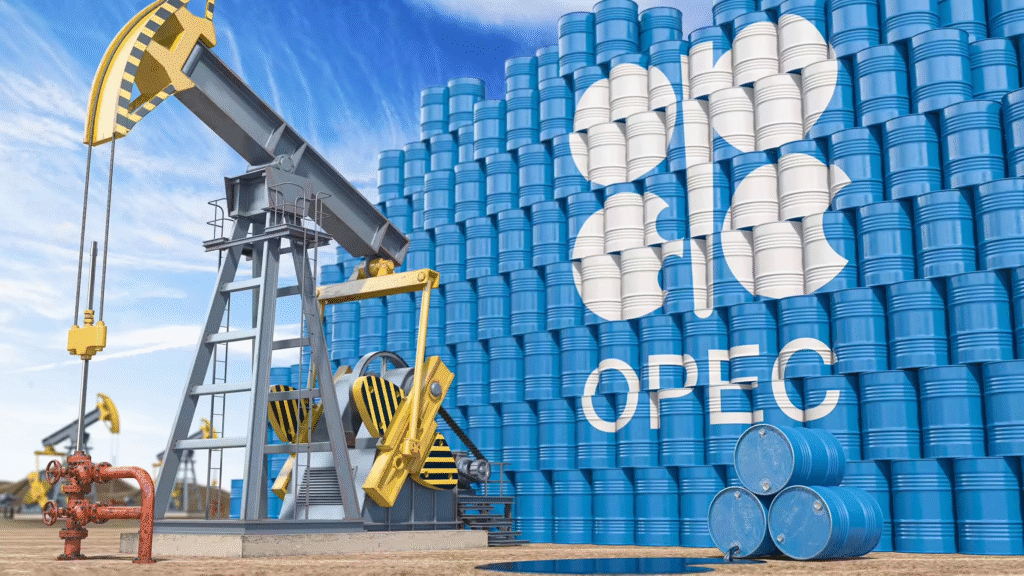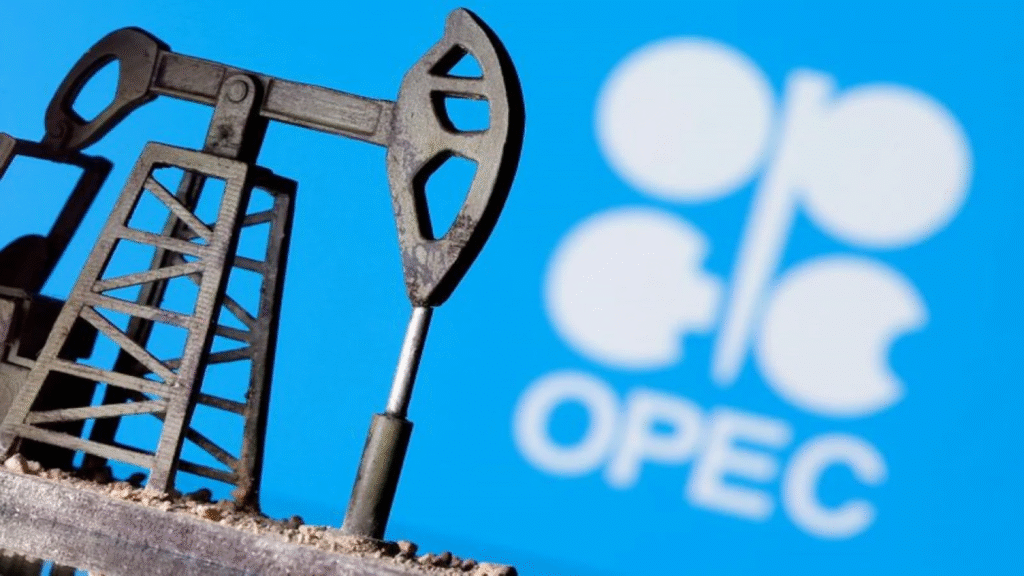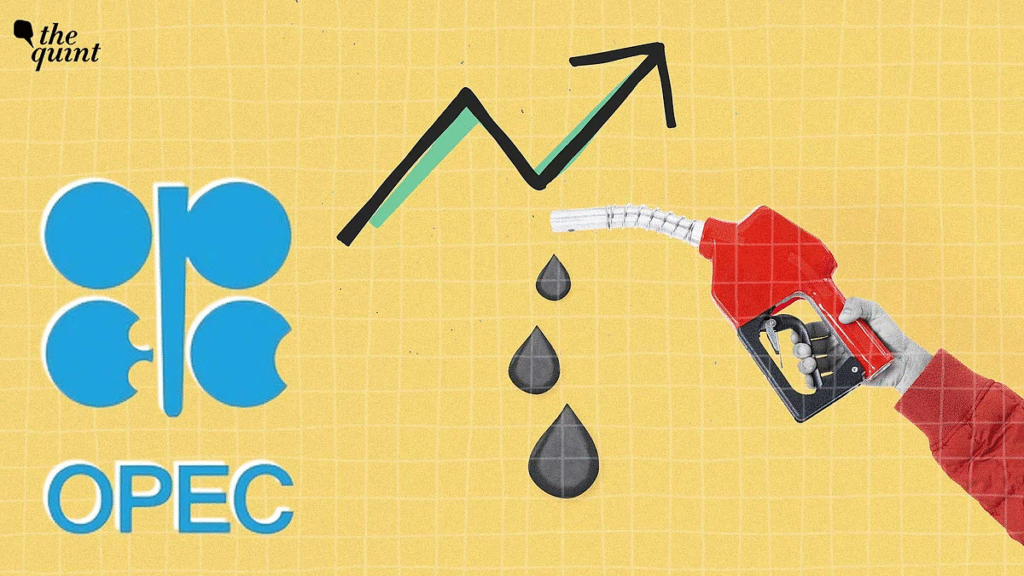OPEC+ production hike in September battered oil prices; here’s what it means globally and for India, fuel costs, and demand dynamics.

(<160 chars)
Would your morning petrol refill soon feel lighter in your wallet? That’s the real concern behind the OPEC+ production hike story hitting headlines. When major oil producers agree to raise output—this time by ~547,000 barrels per day for September—it touches everyone from exporters to Indian commuters. In the next few minutes, you’ll understand why prices dipped despite broad supply, how India fits into the picture, and what to expect in fuel costs.
📊 What Is the OPEC+ Production Hike and Why Now?
- In early August 2025, eight OPEC+ members—including Saudi Arabia, Russia, UAE, Iraq, India-relevant exporters—agreed to raise output by approximately 547,000 barrels per day in September MarketCheese+15Reuters+15Discovery Alert+15Invezz+1EconoTimes+1.
- This builds on a June–August ramp-up (548k bpd in August; previous monthly increases of ~411k) to unwind voluntary cuts gradually MarketWatch+6OPEC+6StreetInsider.com+6.
Why now?
- OPEC+ claims healthy demand and low inventories justify the ramp-up Reuters.
- At the same time, geopolitical tensions involving Russia, sanctions pressure, and U.S. calls (including from Donald Trump) to ease gasoline prices have shaped this pivot fxstreet.com+11Investing.com+11Reuters+11.
Takeaway: It’s not random—it’s a calculated reversal aimed at regaining market share while demand still holds.
📉 How Did Markets Respond and Why Didn’t Prices Crash?
Market reaction
- Brent fell about $0.43 to $69.24, WTI dropped ~0.58% to $66.94, continuing Friday losses of ~$2/barrel Reuters+7Reuters+7cnbcafrica.com+7.
- Yet surprisingly, oil didn’t collapse. The market has absorbed ~2.5 million bpd of returns including UAE’s capacity expansion, representing about 2.4% of global demand offshore-technology.com+2Reuters+2Reuters+2.
Why no price crash
- Asian demand–particularly China’s rebuild of inventories–soaked up barrels Reuters.
- Geopolitical uncertainty—conflicts in the Middle East, U.S. sanctions on Russian oil buyers—underpinned prices Reuters.
- Analysts like Amrita Sen and RBC noted strong fundamentals and tight stocks support price resilience ReutersReutersOPEC.
Takeaway: Supply rose, but demand, geopolitics, and low inventories prevented a freefall.
What Does This Mean for India and Indian Fuel Consumers?
India’s strategic position
- India is a major buyer of Russian crude. U.S. threats of sanctions if India doesn’t reduce Russian oil purchases put pressure on supply sources, potentially disrupting flows fxstreet.com.
- If prices at port rise or import mix shifts, retail fuel prices may edge higher.
Local impact on fuel costs
- Currently (~early August), Brent ~ $69–70/barrel translates to an approximate ₹60–₹62/litre petrol price in India. Any downward pressure might trim retail costs—but taxes, exchange rate, and base price delays matter.
- However, if sanctions disrupt Russian supply or rupee weakens (as happened previously when Brent spiked, pulling rupee past ₹86/USD in June), prices could climb Wikipedia.
Takeaway: Short-term relief may appear, but geopolitical shocks or currency shifts could offset benefits quickly.
💡 The Broader Strategy – Market Share vs. Price

OPEC+ strategic shift
- From January 2024, OPEC+ had imposed ~2.2 million bpd of voluntary cuts to support oil prices. Now they’re winding it down early, with full rollout by September 2025 instead of 2026 StreetInsider.com.
- This is aimed at reclaiming volume share lost to U.S. shale, Brazil, Canada and others while prices hover near $70 Reuters+1The Times of India+1.
Internal dynamics
- Discontent with quota over‑producing members (e.g. Iraq, Kazakhstan) has prompted Saudi Arabia to speed up reversal unless compliance improves Yahoo+3Investing.com+3StreetInsider.com+3.
- Despite internal friction, they’ve coordinated large hikes monthly.
Takeaway: The move signals a shift from price protection to volume fight—and market dominance.
🔮Risks Ahead—Oversupply, Demand Slowdown, Geopolitics

Oversupply risk
- Analysts anticipate a risk of Brent sliding toward $60/barrel by autumn, as oversupply builds and summer demand wanes Invezz.
- Goldman projects Q4 2025 average Brent at ~$64, then $56 in 2026, citing mounting global demand risks and rising inventory levels Reuters.
Demand softening
- Weak U.S. economic indicators, rising tariffs, sluggish global growth could weaken oil consumption in coming quarters Reuters.
Geopolitical uncertainty
- Any disruption from the Middle East or tighter sanctions on Russia/Iran could tighten supplies and boost prices unpredictably ReutersWikipedia.
Takeaway: The strategy may hold short term—but longer term volatility remains likely depending on demand and politics.
✅ Section Key Takeaways
- Structure shift: OPEC+ reversed deeper cuts starting April 2025, adding ~547k bpd for September.
- Price behavior: Despite higher supply, oil hovered near $70 thanks to demand support and geopolitical risk buffers.
- Impact on India: Lower global crude could favor lower pump prices—yet risks from Russian import politics and rupee wavering remain.
- What’s next: Analysts expect potential price downtrend toward $60 in autumn, but geopolitical shocks may reverse trajectory.
CTA
What changes are you spotting at the pump in your city? Do you think fuel prices might drop in coming months—or could unexpected geopolitics push them up? Share your thoughts below and let’s discuss how this global strategy plays out locally.

Will OPEC+ continue raising output?
Likely paused after September unless future market conditions change.
Could oil prices fall further?
Experts see potential dips toward $60/barrel if demand slows and supply rises.
How does this affect fuel prices in India?
Lower crude could ease retail fuel rates—unless Russian sanctions or rupee weakness intervene.
Why did oil prices not crash after the hike?
Geopolitical risk and resilient demand absorbed extra supply.